I might as well tell you from the jump: I did not go into this review of the Mazda3 Turbo as a completely untainted juror. I went in expecting to love it. I was excited, hoping I could reassure my fellow hatchback fans, connoisseurs of practicality and performance, that Mazda had built a vehicle 80 percent as exciting as a Toyota GR Corolla, for 80 percent of the price, with a grown-up interior and no ridiculous markups. There aren’t a lot of enthusiast-minded compacts out there anymore. We need to hold on to the ones we’ve got.
Instead, I come to you confused and a little dejected. The 3 Turbo’s spec sheet reads like Mazda has been listening to every conversation I’ve ever had about my criteria for the ideal car. It’s available as a sedan or a hatchback, with a 2.5-liter four-cylinder making 250 horsepower and 320 lb-ft of torque on 93 octane (dropping to 227 and 310 on 87 octane). It has all-wheel drive, too. For someone who grew up playing Gran Turismo but wants a little more subtlety with their speed, the 3 Turbo sounds like the total package.

But there’s a disconnect between what those specs evoke in your head, and what you feel driving the 3 Turbo. This is no WRX in a tuxedo; hell, it’s not even a WRX Lite. It’s more like an Audi A3 or a Mercedes-Benz A-Class. Judged against those competitors, it’s hard to find fault with the 3 Turbo. This car is playing a different game from the one you thought (or hoped) it was.
Full disclosure: Mazda dropped a 2022 Mazda3 2.5 Turbo Premium Plus hatchback off at my door for a week with a full tank of 93-octane fuel. I refilled it with 87 so I could find out if I’d miss the 23 horsepower. Also because have you seen gas prices lately?
What Is the Mazda3 Turbo?

Mazdaspeed, Mazda’s performance label of yore, is dead, and it ain’t coming back. In its heyday, Mazdaspeed would sell you a Mazda3 with a 260-hp turbo 2.3-liter engine and a six-speed manual, for just $25,000. This wasn’t even 10 years ago, but that recipe sounds incredible today.
If the Mazdaspeed 3 grew up and bought a house in Hackensack, that mature adult car would be today’s Mazda3 Turbo. This is the most powerful version of the fourth-generation Mazda3, with us since the 2019 model year. It comes only with all-wheel drive and only with an automatic transmission. If you want a manual transmission, you’re stuck with a naturally aspirated 2.5-liter engine and front-wheel drive.

That’s a shame, because you have to spend almost $9,000 over the base model to get the Turbo, and I’d personally be willing to lose the AWD to keep things more budget friendly. The Turbo sedan starts at $30,900; the hatch adds $1,850 to that price. The Premium Plus package — the one I drove — offers perforated leather seats, navigation and a swath of tech features, including Mazda’s Traffic Jam Assist and 360-degree-view camera. The MSRP on the car you see here was $36,010.
How Does the Mazda3 Turbo Drive?
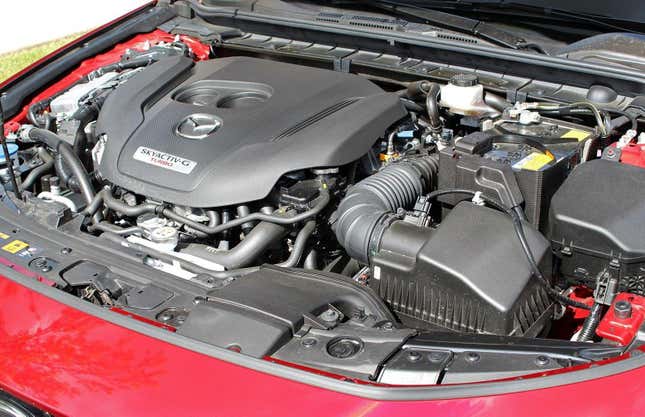
There are several encouraging adjectives I’d use to describe the Mazda3 Turbo driving experience: robust, refined, powerful. The full 320 lb-ft of torque is available at 2,500 rpm, and Mazda’s Dynamic Turbo Pressure system does an excellent job of snuffing out lag.
Mazda quotes a 0-60 mph time of about six seconds. I believe it. Armed with that nifty turbo tech, the four-cylinder pulls hard with even a light dab of throttle, and it never leaves you wanting for more passing punch. While you do get a horsepower penalty on lower-grade fuel, torque is barely affected. On 87 octane, you still get 310 lb-ft of torque at 2,000 rpm. The type of fuel you use doesn’t hugely impact regular driving. The EPA says this hatchback should get you 23 mpg in the city, 32 on the highway, 26 combined. I found that to be accurate, if slightly disappointing.
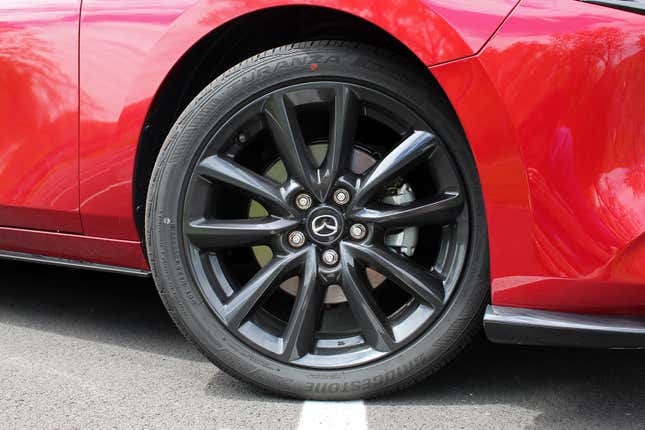
So the Mazda3 Turbo feels plenty quick and confident — in a straight line. The second you turn the wheel, those visions of back-road bliss begin to evaporate. Not entirely, but enough to make you sort of sad.
The steering is heavy. But then, so is the 3 Turbo, with 3,384 pounds to lug around. If you’re accustomed to the pin-sharp turn-in and limited body roll of, say, a Volkswagen GTI, you’ll be let down here.
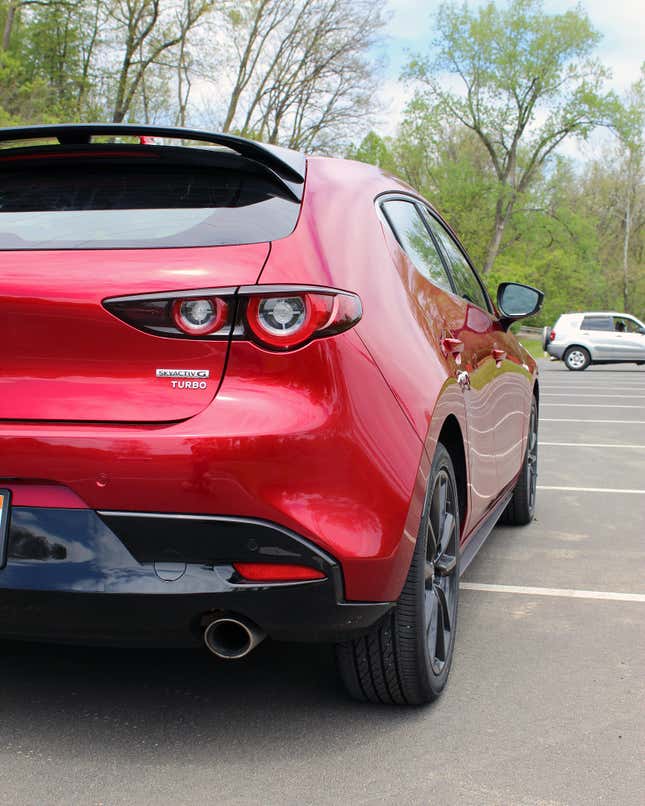
The 3 Turbo feels a little bigger than it is. The ride is more compliant than what you’d expect in a sport-oriented compact, but it still gets choppy on rough roads. There’s an urgency to the powertrain that the chassis doesn’t match. It’s not totally out of its depth in corners, but it never expresses an eagerness to change direction — and behind the wheel, neither will you. The Turbo receives almost no suspension changes relative to the less-powerful Mazda3 trims, save for slightly stiffer front springs to offset the increased weight of the drivetrain. High-performance tires would probably improve things — the factory Bridgestone Turanzas are all-season touring tires with no performance intentions.
If the 3 Turbo’s cornering performance was the criticism I didn’t see coming, its six-speed auto provided a more welcome surprise. Yes, a manual would’ve been lovely, but this transmission is about as good a consolation prize as we were ever going to get short of a DCT. In Sport mode, it keeps the engine suitably high in the rev range, and if you slide the gear selector over into manual mode, you can wring as much thunder out of the Skyactiv-G as you like via the paddle shifters, and the shifting is rapid enough. Had Mazda given me the choice between three pedals or a more agile chassis, I’d take the latter every time.
How Is the Mazda3 Turbo’s Interior?
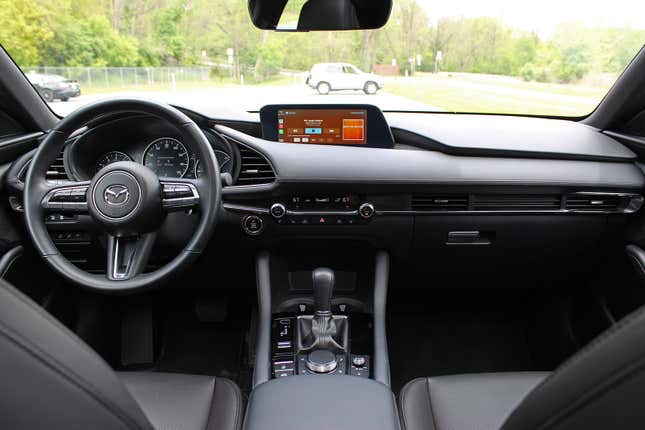
The Mazda3 is saved by its interior, simple as that. The cabin is gorgeous and comfortable, and the build quality and materials are a cut above anything else at this price point. It’s so good that, coupled with the bold exterior design and the strength of the engine, it almost distracts me from the mild driving experience.
I’ll be 30 in a year, I tell myself. Time to grow up and move to Hackensack.

I should point out that I do all my commuting in an orange shoe. I’m easily impressed by features like power memory seats, something I didn’t know you could get at this price from a non-German brand. Or the heads-up display. Or the unbroken strip of brushed silver trim that runs all the way across the dashboard. Yes, I know chrome is usually tacky and cheap. Not this chrome.
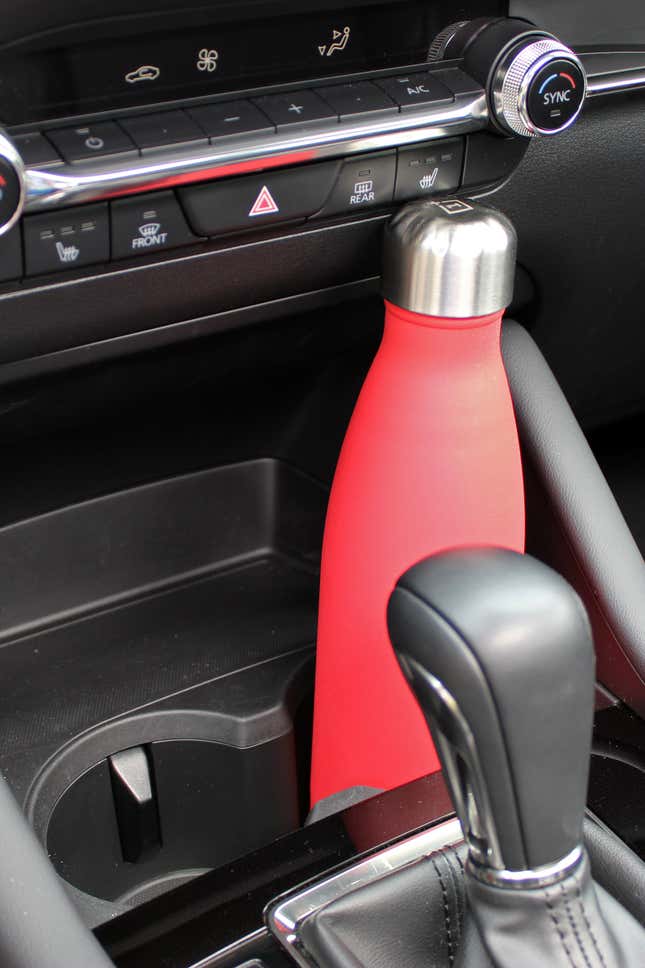
The climate control is an art piece unto itself, a testament to physical knobs and buttons. The instrument cluster has just the right amount of screen. And the 12-speaker Bose audio system, with its subwoofer in the spare-tire well, will convince you you’re sitting in a more expensive place.
I have but two notes for Mazda. One is that the center console cupholder placement is the most laughable design mistake I’ve seen in some time — fortunately, there are less clumsy cupholders in the door pockets. The second is a lengthier one: I despise Mazda’s knob-controlled infotainment system. It mostly works within the car’s built-in user interface, but it’s not equipped to deal with navigation, Apple CarPlay or Android Auto. I’d prefer a touchscreen or a touchpad.
On the flip side, the tiny volume knob to the right of it is adorable and very enjoyable to turn. Love that little guy.
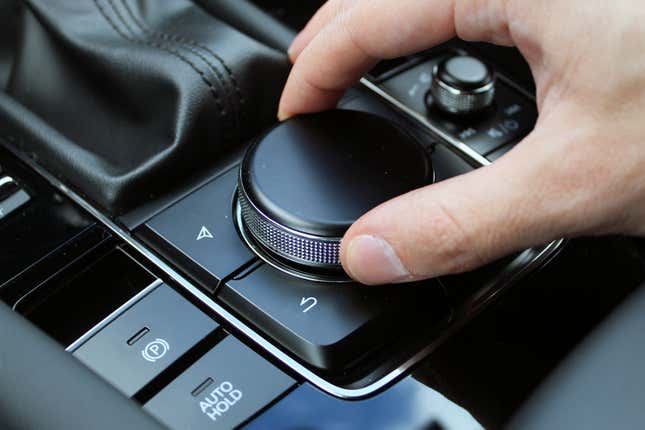
Safety and Everything Else
Shell out for a Premium Plus-trimmed 3 Turbo like the one I tested, and you get a number of exclusive driver assistance luxuries, like autonomous braking (including while backing up), traffic sign recognition and Mazda’s Traffic Jam Assist tech. That last item is a Level 2 semi-autonomous system that handles acceleration, steering and lane centering in stop-and-go traffic, from zero to 40 mph. Given the limited use-case compared to a system that works at higher speeds, like Hyundai’s Highway Driving Assist, it’s something I could frankly take or leave.
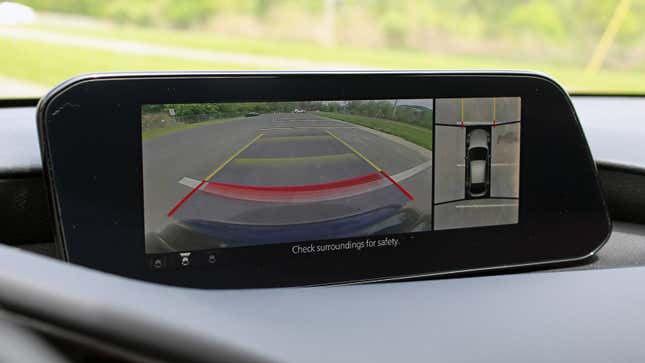
On the other hand, the 360-degree around-view camera is an absolute must in the Mazda3 hatch, considering how comically tiny the rear windows are. The wide C pillars made my test car feel like a bunker, with similar visibility. A 3 hatchback without the camera would be a non-starter for me.
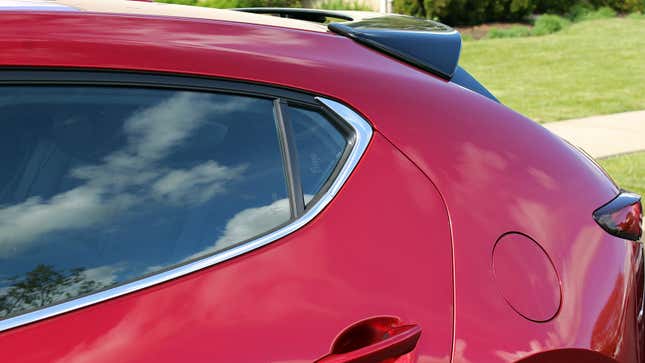
Jalopnik Recommended Options
Which brings us to my other big surprise reviewing the Mazda3 Turbo hatch: I don’t like the hatch! It’s a pain to see out of, it looks ungainly from certain angles, and, given the sloping roof, it doesn’t even offer a space advantage for passengers or tall cargo.
I sat in the back seat behind where I’d position the driver’s seat. I’m 5-foot-10, 155 pounds, and my knees were digging into the leather in front of me while my hair brushed the roof. This is a car that cosplays practicality. If you want a usable liftgate and expect more frequent back-seat passengers, maybe consider the Mazda CX-30. That crossover benefits from the same engine — and largely the same interior — as the the Mazda3. It’s not massively roomier, but it’s a step up from this.
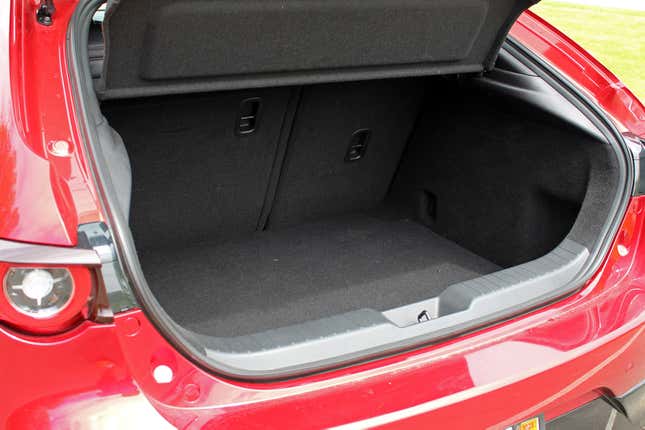
The 3 Turbo sedan is $1,850 less than the hatch, and because it’s so much easier to see out of, you can choose the standard Turbo configuration without forgoing necessary luxuries like that 360-degree camera. I think it looks a little leaner, too. The sedan starts at $30,050 excluding a $1,000 destination charge. I reckon that’s a much more reasonable sum for this car, versus $34,750 for the range-topping hatch.
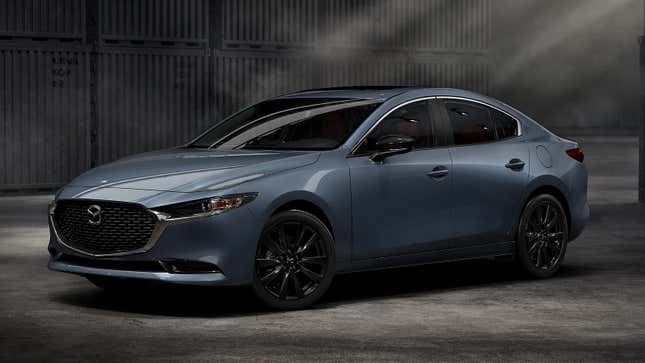
Class and Competition
For better or worse, the Mazda3 Turbo has no direct competitors. Sure, it enjoys a price advantage compared to the more posh German offerings. The Mercedes A-Class and Audi A3 begin at about $34,000, but that really is the basement for both cars — at that price, you’re settling for front-wheel drive and considerably less power. Compared to those — and considering the style, fit and finish of Mazda’s interior — the 3 Turbo feels like a bargain.
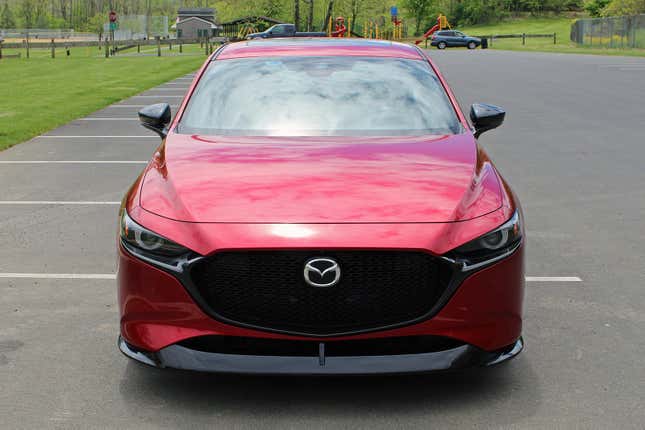
It’s the sportier set where things get interesting. If you’re looking for a little more driving verve but not an all-out screamer, the new Civic Si seems like a more compelling alternative. It’s also considerably cheaper, starting at $27,500. Honda offers a manual transmission, and the combination of less weight and power make the Civic Si more fuel efficient than the 3 Turbo, too. Immediately after spending a week with this Mazda, that’s the one I’d want to drive next. The new Acura Integra and Volkswagen Jetta GLI enter the conversation, too.

Then there’s the true hot hatch set — the VW GTI at a shade under $30,000 and the Hyundai Veloster N at $32,000. Interior quality will take a hit here, as will usable space in the case of the Hyundai. If you were endeared to the Mazda for its comfort or its baby-grand-tourer demeanor, either of these choices might be too rough, too uncompromising for you. The average new car costs about $43,000 now, so in the low $30,000 range, you’re not going to check every possible box. Decisions, decisions.
The Verdict
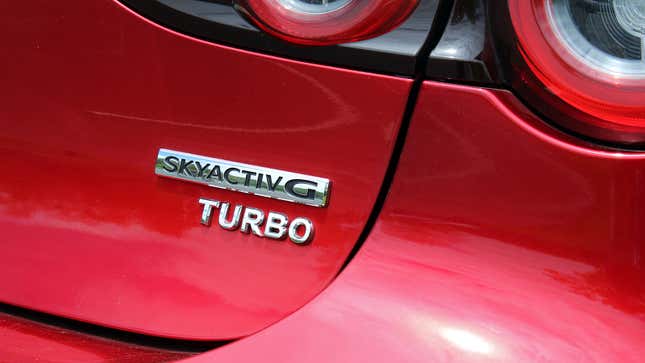
The Mazda 3 Turbo isn’t the car I thought it would be. And while that’s not Mazda’s fault, nevertheless I’m left thinking this is a vehicle for a very specific buyer, with a very specific criteria. The kind of customer who desires luxury and a sense of performance and practicality, without actually being too fussed about either.
But then I’m reminded of Mazda’s self-professed philosophy of jinba ittai — the ideal of “horse and rider as one,” minted in the tradition of Japanese mounted archery and invoked any time someone whispers the word “Miata.”
I’m all for Mazda’s maturity arc; the brand needed to do something to stand apart from its Japanese contemporaries, and it has more or less achieved that. There’s no question that the Mazda3 Turbo is a seriously premium machine — you feel it the moment you get inside. Just don’t hold your breath for the oneness to wash over you.